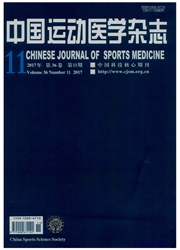

 中文摘要:
中文摘要:
目的:观察有氧运动对高血压大鼠肠系膜动脉平滑肌细胞L型钙(CaL)通道功能的影响。方法:选取雄性12周龄正常血压大鼠(WKY组)12只、自发性高血压大鼠(SHR)24只。高血压大鼠随机分为2组:安静对照组(SHR,n=12)和有氧运动组(SHR-EX,n=12)。运动组进行8周跑台运动(20 m/min,60 min/d,5 d/w)。8周后,分别取各组大鼠肠系膜动脉,经酶消化获得单个平滑肌细胞。然后采用全细胞记录模式,观察各组CaL通道电流。结果:(1)收缩压和舒张压:SHR-EX组较SHR组显著降低,但仍高于WKY组;心率:SHR-EX组较SHR组显著降低,与WKY组之间无显著差异。(2)CaL通道电流幅值与电流密度:SHR组较WKY组显著增加,而SHR-EX组较SHR组却显著降低。(3)电压依赖性激活曲线和失活曲线:各组激活,失活曲线斜率和Vh均无显著差异。结论:高血压可引起肠系膜动脉平滑肌细胞CaL通道功能上调,表现为全细胞电流增加,而长期规律性有氧运动可显著抑制此变化,这可能是运动有效缓解高血压的重要外周机制之一。
 英文摘要:
英文摘要:
Objective To investigate the effects of aerobic exercise on the function of the type L Ca2+(CaL)channel in smooth muscle cells of mesenteric artery in rats. Methods Twelve-week-old 12 male normotensive Wistar-Kyoto rats(group WKY),and 24 spontaneously hypertensive rats(group SHR) were used in this study.Rats in the group SHR were randomly assigned into a sedentary group(SHR,n=12) and an exercise-trained group(SHR-EX,n=12). Rats in group SHR-EX underwent treadmill exercise at the speed of 20m/min, 60 min per day,and 5 days per week. After 8 weeks of experiment, the mesenteric arteries were removed, and their smooth muscle cells were obtained by using enzymatic isolation method. CaLchannel current was examined by using whole cell patch clamp recording technique. Result(1)The systolic blood pressure and diastolic blood pressure in group SHR-EX were obviously lower than those in group SHR, but still higher than those in group WKY. Compared with group SHR, the heart rate in group SHR-EX was significantly lower than group SHR,but was not significantly different from that in group WKY.(2)The current value and current density in group SHR were extremely higher than group WKY, while the increase after exercise training(group SHR-EX) was significantly inhibited.(3)There were no significant differences in voltage dependence activation and inactivation curves among the three groups. No differences in the slopes and Vhwere observed. Conclusion Hypertension induces functional upregulation of CaLchannel in mesenteric arterial smooth muscle cell, while regular aerobic exercise significantly inhibits such upregulation, which may be one of the important mechanisms underlying the effectiveness of exercise on lowering blood pressure.
 同期刊论文项目
同期刊论文项目
 同项目期刊论文
同项目期刊论文
 期刊信息
期刊信息
